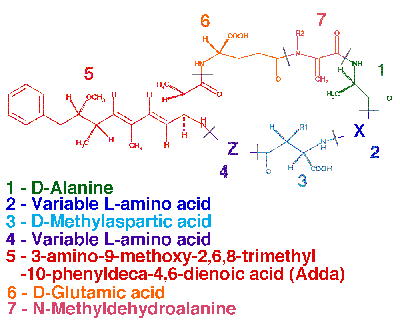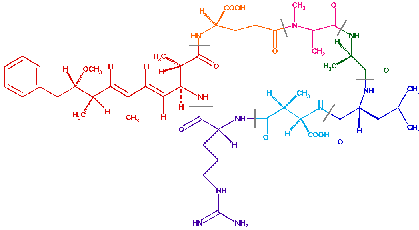 | ||
Testing for deadly toxins ospr gets microcystin testing equipment
Microcystins — or cyanoginosins — are a class of toxins produced by certain freshwater cyanobacteria; primarily Microcystis aeruginosa but also other Microcystis, as well as members of the Planktothrix, Anabaena, Oscillatoria and Nostoc genera. Over 50 different microcystins have been discovered so far, of which microcystin-LR is the most common. Chemically they are cyclic heptapeptides produced through nonribosomal peptide synthases.
Contents
- Testing for deadly toxins ospr gets microcystin testing equipment
- What you need to know about microcystin
- Characteristics
- Exposure
- Formation
- Pathways
- Cyanobacteria blooms
- Lake Erie Blooms
- San Francisco Bay Area
- Removal
- Protection
- References

Microcystins can be produced in large quantities during algal blooms and pose a major threat to drinking and irrigation water supplies, as well as the environment at large.

What you need to know about microcystin
Characteristics

Microcystin-LR is the most toxic form of over 80 known toxic variants, and is also the most studied by chemists, pharmacologists, biologists, and ecologists. Microcystin-containing 'blooms' are a problem worldwide, including China, Brazil, Australia, South Africa, the United States and much of Europe. Hartebeespoort Dam in South Africa is one of the most contaminated sites in Africa, and possibly in the entire world.

Microcystins contain several uncommon non-proteinogenic amino acids such as dehydroalanine derivatives and the uncommon β-amino acid ADDA. Microcystins covalently bond to and inhibit protein phosphatases PP1 and PP2A and can thus cause pansteatitis.
Exposure
Microcystins are hepatotoxic (able to cause serious damage to the liver). Once ingested, microcystin travels to the liver, via the bile acid transport system, where most is stored; though some remains in the blood stream and may contaminate tissue. There appears to be inadequate information to assess the carcinogenic potential of microcystins by applying EPA Guidelines for Carcinogen Risk Assessment. A few studies suggest a relationship may exist between liver and colorectral cancers and the occurrence of cyanobacteria in drinking water in China. Evidence is, however, limited due to limited ability to accurately assess and measure exposure.
The impact of exposure to microcystin by patients with a compromised immune system is not yet fully known, but is starting to raise some concern.
Formation
The microcystin-producing microcystis, is a genus of freshwater cyanobacteria and is projected to thrive with warmer climate conditions, such as the rise of water temperatures or in stagnant waters, and through the process of eutrophication (oversupply of nutrients). An Ohio state task force found that Lake Erie received more phosphorus than any other Great Lake, both from crop land, due to the farming practices, and from urban water-treatment centres. Evidence developed at the University of Heidelberg suggests that in particular dissolved reactive phosphorus promotes additional growth.
Pathways
Microcystin-producing bacteria blooms can overwhelm the filter capacities of water treatment plants. Some evidence shows the toxin can be transported by irrigation into the food chain, Microcystins are chemically stable over a wide range of temperature and pH, possibly as a result of their cyclic structure. Due to their cyclic nature they cannot be broken down by standard proteases like pepsin, trypsin, collagenase, and chymotrypsin.
Cyanobacteria blooms
A study concluded in 2009 that climate change can act as a catalyst for global expansion of harmful cyanobacterial blooms. The EPA reported in 2013, that changing environmental conditions such as harmful algae growth is associated with current climate change, and may negatively impact the environment, human health, and the economy for communities across the US and around the world.
Lake Erie Blooms
A record outbreak of blooming microcystis occurred in Lake Erie 2011, in part related to the wettest spring on record, and expanded lake bottom dead zones, reduced fish populations, fouled beaches, and the local tourism industry that generates more than $10 billion in revenue annually.
On 2 August 2014, the City of Toledo, Ohio detected higher levels of microcystin than deemed safe in its water supply due to harmful algal blooms (HABs) in Lake Erie, the shallowest of the Great Lakes. They issued a DO NOT DRINK OR BOIL water advisory to approximately 500,000 people. Algal blooms have been occurring more frequently, and scientists had predicted this significant bloom of blue-green algae to peak in early September.
San Francisco Bay Area
Microcystin has been found in San Francisco Bay Area shellfish in seawater, apparently from freshwater runoff, exacerbated by drought.
Removal
Plastic containers other than PETG can absorb microcystins such that detection is not possible. This is also true of some other cyanotoxins.
Protection
Both green tea and sulforaphane have been shown to have a protective effect against microcystin induced toxicity.
